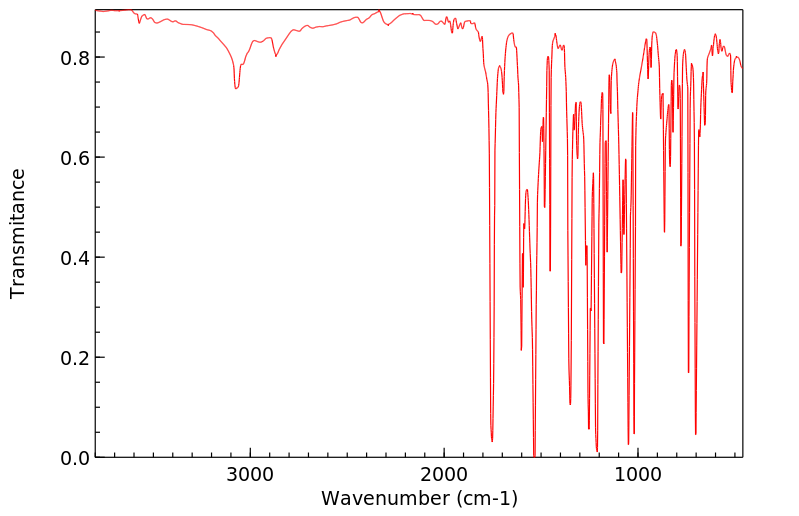(2-硝基苯基)苯甲酸酯 | 1523-12-2
物质功能分类
分子结构分类
中文名称
(2-硝基苯基)苯甲酸酯
中文别名
——
英文名称
2-nitrophenyl benzoate
英文别名
2-Nitrophenylbenzoat;o-nitrophenyl benzoate;<2-Nitro-phenyl>-benzoat;o-Nitrophenyl-benzoat;Benzoesaeure-o-nitrophenylester;(2-nitrophenyl) benzoate
CAS
1523-12-2
化学式
C13H9NO4
mdl
——
分子量
243.219
InChiKey
PNBOBRKDXRJMTL-UHFFFAOYSA-N
BEILSTEIN
——
EINECS
——
-
物化性质
-
计算性质
-
ADMET
-
安全信息
-
SDS
-
制备方法与用途
-
上下游信息
-
文献信息
-
表征谱图
-
同类化合物
-
相关功能分类
-
相关结构分类
计算性质
-
辛醇/水分配系数(LogP):3.2
-
重原子数:18
-
可旋转键数:3
-
环数:2.0
-
sp3杂化的碳原子比例:0.0
-
拓扑面积:72.1
-
氢给体数:0
-
氢受体数:4
SDS
上下游信息
-
上游原料
中文名称 英文名称 CAS号 化学式 分子量 1-苄氧基-2-硝基苯 2-benzyloxynitrobenzene 4560-41-2 C13H11NO3 229.235 -
下游产品
中文名称 英文名称 CAS号 化学式 分子量 —— o-Aminophenylbenzoat 721-48-2 C13H11NO2 213.236
反应信息
-
作为反应物:描述:(2-硝基苯基)苯甲酸酯 在 二氢吡啶 、 10% palladium on activated carbon 作用下, 以 溶剂黄146 为溶剂, 反应 15.0h, 以83%的产率得到2-苯基苯并恶唑参考文献:名称:苯并恶唑和苯并咪唑的简便高效合成:Hantzsch 酯 1,4-二氢吡啶在还原环化反应中的应用摘要:苯并恶唑和苯并咪唑都是具有生物活性和药用意义的化合物中常见的杂环支架。邻位取代硝基苯衍生物的还原环化为苯并恶唑或苯并咪唑环的形成提供了一条有吸引力的途径。不幸的是,仅报道了几种通过邻硝基化合物还原环化的合成方法,并且产率相当低。在合成有用的有机转化中仿生还原剂的继续开发中,Hantzsch 酯 1,4-二氢吡啶 (HEH),NAD(P)H 的类似物,引起了相当多的关注。因此,我们希望报告可以通过邻位取代的硝基苯衍生物与 Pd/C 催化的 HEH 反应有效合成苯并恶唑和苯并咪唑。一系列功能化的邻硝基苯基酯或邻硝基苯基酰胺被 HEH 有效还原并环化为相应的苯并恶唑或苯并咪唑。特别是,在相同取代基的存在下工作,相对于相应的苯并恶唑,可以以更高的产率获得苯并咪唑。此外,在目前的工作中,对 Pd/C 的回收进行了研究,结果表明在五次运行中仍能保持其高催化活性。根据我们的实验结果和 DFT 计算,提出DOI:10.1002/ejoc.201000985
-
作为产物:描述:苯甲酰氯 生成 (2-硝基苯基)苯甲酸酯参考文献:名称:SALUNKHE D. G.; MANE R. B.; JAGDALE M. H.; SALUNKHE M. M., CURR. SCI., 55,(1986) N 17, 853-854摘要:DOI:
文献信息
-
Iterative Design of a Biomimetic Catalyst for Amino Acid Thioester Condensation作者:Huabin Wu、Handoko、Monika Raj、Paramjit S. AroraDOI:10.1021/acs.orglett.7b02412日期:2017.10.6combines lessons learned from peptide biosynthesis, enzymes, and organocatalysts is described. The catalyst features a urea scaffold for carbonyl recognition and elements of nucleophilic catalysis. In the presence of 10 mol % of the organocatalyst, the rate of peptide bond formation is accelerated by 10000-fold over the uncatalyzed reaction between Fmoc-amino acid thioesters and amino acid methyl esters
-
Bismuth(III) salts as convenient and efficient catalysts for the selective acetylation and benzoylation of alcohols and phenols作者:Iraj Mohammadpoor-Baltork、Hamid Aliyan、Ahmad Reza KhosropourDOI:10.1016/s0040-4020(01)00521-x日期:2001.7Efficient acetylation and benzoylation of alcohols and phenols with acetic and benzoic anhydrides have been carried out under catalysis of bismuth(III) salts including BiCl3, Bi(TFA)3 and Bi(OTf)3. Selective acetylation and benzoylation of alcohols in the presence of phenols is an additional advantage of this procedure.
-
Benzoyl peroxide–imidazole: a novel and efficient reagent for the mild conversion of alcohols or phenols into benzoates作者:Najmeh Nowrouzi、Seyedeh Zahra AlizadehDOI:10.1016/j.tetlet.2013.02.101日期:2013.5A very mild, one-pot, and expedient protocol for the conversion of alcohols and phenols into their corresponding benzoates using imidazole and benzoyl peroxide as a novel reagent is described.
-
Zinc oxide (ZnO) as a new, highly efficient, and reusable catalyst for acylation of alcohols, phenols and amines under solvent free conditions作者:Mona Hosseini Sarvari、Hashem SharghiDOI:10.1016/j.tet.2005.09.002日期:2005.11Zinc oxide (ZnO) is a highly efficient catalyst for the acylation of a variety of alcohols, phenols and amines with acid chlorides or acid anhydrides under solvent free conditions. Primary, secondary, tertiary, allylic and benzylic alcohols, diols and phenols with electron donating or withdrawing substituents can be easily acylated in good to excellent yield.
-
4-(<i>N,N</i>-Dimethylamino)pyridine Hydrochloride as a Recyclable Catalyst for Acylation of Inert Alcohols: Substrate Scope and Reaction Mechanism作者:Zhihui Liu、Qiaoqiao Ma、Yuxiu Liu、Qingmin WangDOI:10.1021/ol4030875日期:2014.1.34-(N,N-Dimethylamino)pyridine hydrochloride (DMAP·HCl), a DMAP salt with the simplest structure, was used as a recyclable catalyst for the acylation of inert alcohols and phenols under base-free conditions. The reaction mechanism was investigated in detail for the first time; DMAP·HCl and the acylating reagent directly formed N-acyl-4-(N′,N′-dimethylamino)pyridine chloride, which was attacked by the
表征谱图
-
氢谱1HNMR
-
质谱MS
-
碳谱13CNMR
-
红外IR
-
拉曼Raman
-
峰位数据
-
峰位匹配
-
表征信息
同类化合物
非那米柳
雷尼替丁
降钙素(humanreduced),8-L-缬氨酸-(9CI)
间苯甲酰氧基苯乙酮
间苯二甲酸二苯酯
间甲苯基苯甲酸酯
间双没食子酸
醋氨沙洛
邻苯二甲酸苄酯2-乙己基酯
邻苯二甲酸二苯酯-D4
邻苯二甲酸二苯酯
邻甲苯基苯甲酸酯
邻氨基苯甲酸(4-硝基苯基)酯
邻亚苯基二苯甲酸酯
贝诺酯
袋衣酸
血竭黄烷A
萘-1,5-二磺酸-4-[2-(二甲氨基)乙氧基]-2-甲基-5-(丙烷-2-基)苯基2-氨基苯酸酯(1:1)
茶痂衣酸
苯酚,2-[2-[(4-氯苯基)氨基]-4-噻唑基]-,苯酸酯(ester)
苯甲醯柳酸甲酯
苯甲酸苯酯
苯甲酸五氟苯酯
苯甲酸丁香酚酯
苯甲酸4-[[(4-甲氧基苯基)亚甲基]氨基]苯基酯
苯甲酸4-(乙酰氨基)-2-[[2-[4-(乙酰氨基)苯甲酰基]亚肼基]甲基]苯基酯
苯甲酸2-(2-苯并恶唑基)苯酯
苯甲酸-4-甲基苯酯
苯甲酸-(4-环戊基-苯基酯)
苯甲酸-(2-烯丙基-4-溴-苯基酯)
苯甲酸-(2-溴-4,6-二硝基-苯基酯)
苯甲酸-(2,4-二溴-3-甲基-苯基酯)
苯甲酸-(2,4-二氯-5-甲基-苯基酯)
苯甲酸-(2,4-二叔丁基苯基酯)
苯甲酸,4-羟基-,4-[(4-羟基苯氧基)羰基]苯基酯
苯甲酸,4-羟基-,4-(己氧基)苯基酯
苯甲酸,4-羟基-,4-(十四烷氧基)苯基酯
苯甲酸,4-羟基-,4-(十二烷氧基)苯基酯
苯甲酸,4-甲酰基-,4-(辛氧基)苯基酯
苯甲酸,4-甲氧基-,2-甲酰基苯基酯
苯甲酸,4-甲基-,4-甲基苯基酯
苯甲酸,4-戊基-,4-(壬氧基)苯基酯
苯甲酸,4-丁氧基-,1,4-亚苯基酯
苯甲酸,4-[[[3-[(2,2-二甲基-1-羰基丙氧基)甲基]-3,4-二氢-2-甲基-4-羰基-6-喹唑啉基]甲基]-2-炔丙基氨基]-,五氟苯基酯
苯甲酸,4-[1-(己氧基)乙基]-,4-(辛氧基)苯基酯
苯甲酸,4-(辛氧基)-,4-[[4-[[(1-甲基庚基)氧代]羰基]苯基]乙炔基]苯基酯
苯甲酸,4-(苯基甲氧基)-,4-(癸氧基)苯基酯
苯甲酸,4-(苯基甲氧基)-,4-(壬氧基)苯基酯
苯甲酸,4-(苯基甲氧基)-,4-(十二烷氧基)苯基酯
苯甲酸,4-(癸氧基)-,4-[氰基[(1-羰基戊基)氧代]甲基]苯基酯,(R)-







